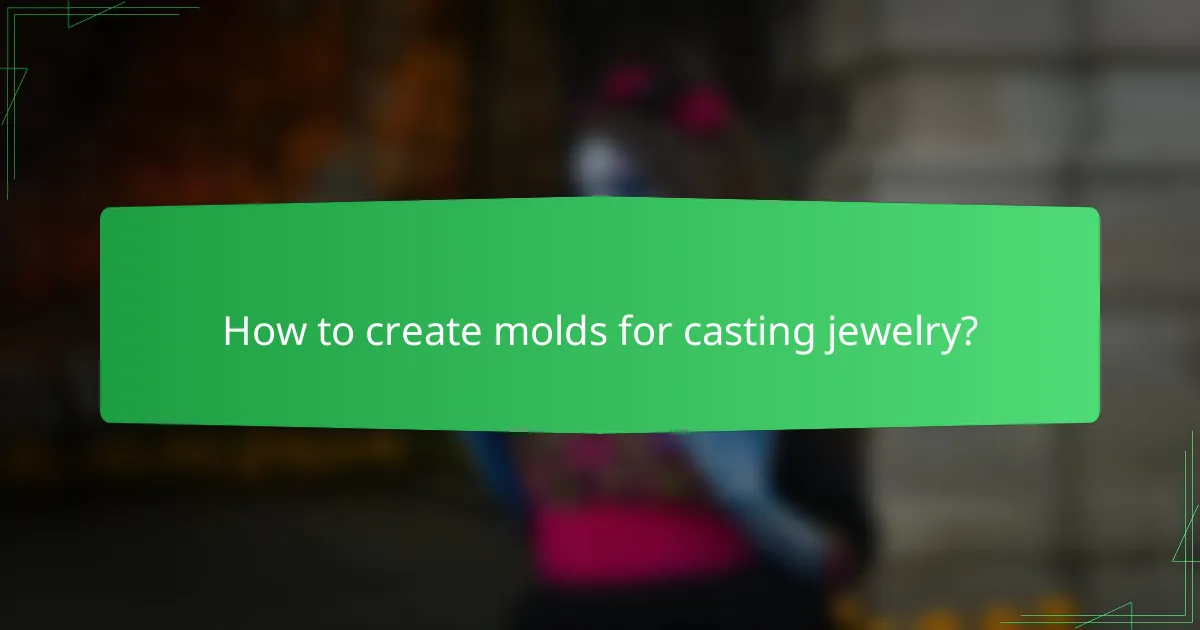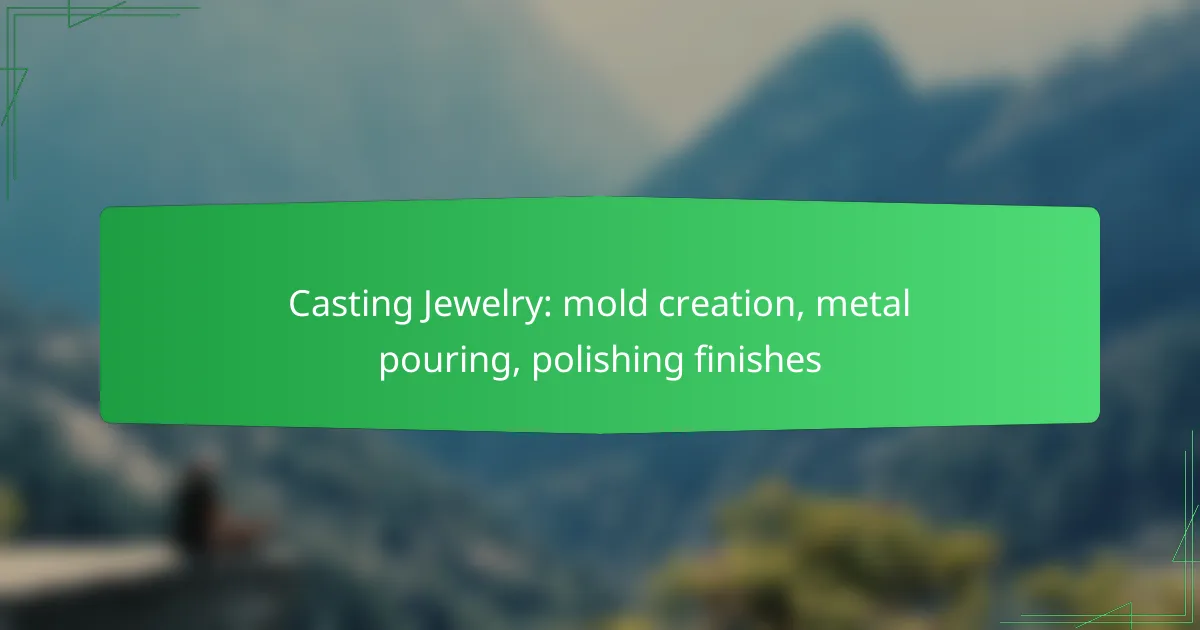Casting jewelry is a meticulous process that begins with creating molds designed to capture intricate details and ensure high-quality results. The selection of metals, such as gold, silver, or bronze, plays a crucial role in determining the durability and aesthetic appeal of the final piece. Once the molds are prepared, metal is poured using precise techniques tailored to the design’s complexity, followed by polishing to achieve a flawless finish.

How to create molds for casting jewelry?
Creating molds for casting jewelry involves selecting the right materials and techniques to ensure precision and quality in the final product. The choice of mold type can significantly impact the detail and durability of the cast pieces.
Silicone mold techniques
Silicone molds are popular for their flexibility and ability to capture intricate details. They are made by mixing silicone rubber with a catalyst, which cures into a durable mold. This technique allows for easy demolding of the cast piece without damaging it.
When using silicone, consider the thickness of the mold; a range of 1-2 cm is often sufficient for most jewelry pieces. Ensure that the silicone is mixed thoroughly to avoid bubbles, which can affect the final product.
Plaster mold methods
Plaster molds are another option, commonly used for their affordability and ease of use. This method involves creating a two-part mold by pouring plaster around a model, allowing it to harden before removing the original piece. Plaster molds can provide a good level of detail but are less flexible than silicone.
For best results, use a release agent on the original model to prevent sticking. Keep in mind that plaster molds may require more time to set, typically several hours, and they are best for lower volume production due to their fragility.
3D printing for molds
3D printing offers a modern approach to mold creation, allowing for complex designs that traditional methods might struggle to achieve. This technique involves using a 3D printer to create a mold directly from a digital design, which can be made from various materials, including plastics and resins.
When considering 3D printing, ensure that the printer resolution is high enough to capture fine details. Additionally, post-processing may be necessary to smooth the surface of the mold, which can improve the quality of the final cast piece. This method is particularly useful for custom designs and small production runs.

What metals are commonly used in jewelry casting?
Jewelry casting typically involves metals like gold, silver, bronze, and brass, each offering unique properties and aesthetic qualities. The choice of metal affects the final piece’s durability, appearance, and cost, making it essential to select the right material for your design.
Gold alloys
Gold alloys are popular in jewelry casting due to their luster and malleability. Common gold alloys include 10K, 14K, and 18K, which indicate the gold content in parts per thousand. Higher karat gold contains more pure gold, resulting in a richer color but lower durability compared to lower karat options.
When casting with gold, consider the alloying metals used, such as copper or silver, which can influence the color and hardness. For example, rose gold is created by adding copper, giving it a warm hue, while white gold typically includes palladium or nickel for a silvery appearance.
Silver types
Silver used in jewelry casting mainly comes in two forms: sterling silver and fine silver. Sterling silver, composed of 92.5% silver and 7.5% other metals (often copper), is the standard for durability and is widely used in jewelry making. Fine silver, at 99.9% purity, is softer and less suitable for intricate designs.
When selecting silver for casting, be aware of the tarnishing properties. Sterling silver can tarnish over time, but it can be polished to restore its shine. Some jewelers opt for argentium silver, which contains germanium, making it more resistant to tarnishing.
Bronze and brass options
Bronze and brass are popular alternatives to precious metals in jewelry casting, offering affordability and unique finishes. Bronze, typically an alloy of copper and tin, provides a warm, reddish-brown color and is known for its strength and resistance to corrosion.
Brass, an alloy of copper and zinc, has a bright yellow appearance that resembles gold but is much more budget-friendly. Both metals can be easily cast and polished, but they may require additional care to prevent tarnishing. Consider sealing your pieces with a protective coating to maintain their luster over time.

How is metal poured in jewelry casting?
Metal is poured in jewelry casting through various techniques that ensure precision and quality in the final product. The method chosen often depends on the design complexity, type of metal, and desired finish.
Investment casting process
The investment casting process involves creating a wax model of the jewelry piece, which is then coated in a ceramic shell. Once the shell hardens, the wax is melted away, leaving a cavity for the molten metal.
This method is highly precise and ideal for intricate designs, making it popular among jewelers. However, it can be more time-consuming and costly compared to other casting methods.
Sand casting techniques
Sand casting techniques utilize a mixture of sand and a binding agent to create molds. The metal is poured into these molds, which can be reused multiple times, making this method cost-effective for larger production runs.
While sand casting is less precise than investment casting, it is suitable for simpler designs and larger pieces. Jewelers often choose this method for its efficiency and lower material costs.
Lost wax method
The lost wax method is similar to investment casting, where a wax model is created and then encased in a mold. After the mold is heated to remove the wax, molten metal is poured into the cavity.
This technique allows for high detail and is often used for custom pieces. However, it requires careful temperature control and timing to ensure the metal flows properly and fills all areas of the mold.

What polishing finishes are available for cast jewelry?
Cast jewelry can feature various polishing finishes that enhance its appearance and durability. The most common finishes include high-polish, brushed, and antique, each offering a distinct look and feel.
High-polish finish
A high-polish finish is characterized by its shiny, reflective surface, achieved through extensive buffing and polishing. This finish is popular for its ability to highlight the details and contours of the jewelry, making it visually striking.
To achieve a high-polish finish, jewelers typically use polishing compounds and buffing wheels. It’s important to ensure that the surface is free from scratches and imperfections before polishing, as these will be magnified by the reflective surface.
Brushed finish
The brushed finish provides a textured appearance, created by rubbing the surface with a fine abrasive material. This finish offers a more understated look compared to high-polish, appealing to those who prefer a matte aesthetic.
When applying a brushed finish, jewelers can control the direction and intensity of the brushing to create unique patterns. This finish is often favored for contemporary designs and can help hide minor scratches better than a high-polish finish.
Antique finish
An antique finish gives jewelry a vintage look, often achieved by oxidizing the surface to create depth and contrast. This finish emphasizes the details of the design, making it ideal for intricate pieces.
To create an antique finish, jewelers may use chemical patinas or apply a darkening agent, followed by polishing to highlight raised areas. This finish can be particularly effective in enhancing the character of heirloom or themed jewelry designs.

What are the prerequisites for casting jewelry?
To successfully cast jewelry, you need a solid understanding of the casting process, including mold creation, metal pouring, and finishing techniques. Familiarity with the required tools and safety measures is essential for producing high-quality pieces while ensuring a safe working environment.
Required tools and equipment
Essential tools for jewelry casting include a furnace for melting metal, a casting machine, and various molds made from materials like silicone or plaster. Additional equipment such as a vacuum chamber, crucibles, and a scale for measuring metal are also important for accuracy and efficiency.
For finishing, tools like polishing wheels, files, and sandpaper are necessary to achieve a smooth surface. Investing in quality equipment can significantly affect the final appearance of your jewelry, so consider both functionality and durability when selecting tools.
Safety measures
Safety is paramount when casting jewelry due to the high temperatures and potentially hazardous materials involved. Always wear protective gear, including heat-resistant gloves, goggles, and a respirator, to safeguard against fumes and splashes.
Ensure your workspace is well-ventilated and free from flammable materials. Familiarize yourself with emergency procedures and keep a first aid kit readily available. Regularly inspect your equipment for wear and tear to prevent accidents during the casting process.

How to choose the right casting method for jewelry?
Selecting the appropriate casting method for jewelry involves understanding the specific requirements of your design, including material, complexity, and budget. Common methods include lost-wax casting, sand casting, and investment casting, each with its own advantages and limitations.
Cost considerations
The cost of casting jewelry can vary significantly based on the method chosen. Lost-wax casting tends to be more expensive due to the intricate processes involved, while sand casting is generally more affordable but may not capture fine details as well.
When budgeting, consider not only the initial costs of materials and labor but also potential expenses for post-casting processes like polishing and finishing. For small-scale projects, you might expect costs to range from a few hundred to several thousand dollars depending on complexity and material choice.
Design complexity
Design complexity plays a crucial role in determining the most suitable casting method. Intricate designs with fine details are best suited for lost-wax casting, which allows for high precision and smooth finishes. In contrast, simpler designs can be effectively produced using sand casting.
Evaluate your design’s requirements, such as undercuts and surface texture, to choose the right method. For example, if your design includes detailed engravings or delicate features, investing in lost-wax casting may be worthwhile despite the higher cost.
